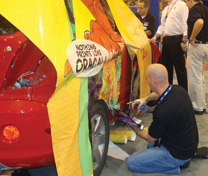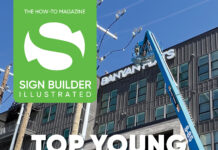 Mike Antoniak
Mike Antoniak
When independent sign shop owners start investigating ways to take business to the next level, new equipment usually figures prominently in their plans. A printer, cutter, or laminator won’t transform the business alone however. It’s the marketing of services that often determines the return on investment.
Financing Assistance
So buying a new piece of equipment may be the easy part. Even in today’s tough economy, those who qualify and can demonstrate sound financial management will find vendors eager to facilitate that next purchase. The goal of Epson Financial Services, for example, is “to help customers integrate new technology into their workflows to grow and expand their business,” says Reed Hecht, product manager for Epson Professional Imaging of Epson America (www.epson.com).
Through the program, the company works with customers to tailor a finance program that makes an investment in Epson Stylus Pro technology a manageable expense. The financing package can cover it all: hardware, consumables, training, maintenance, even installation. “[It] helps customers with new purchases, upgrades, and expansions by creating a tailored solution to meet specific business, monetary, and timing needs,” explains Hecht.
{readmorelink}Read more about{/readmorelink}
Equipment trade-in/upgrade programs are another approach that can help the shop owner expand capabilities. Randy Paar, display graphic product manager for Océ North America (www.oceusa.com), says “attractive trade-up offers” on the company’s Arizona 250GT UV flatbed printer benefits both new and established customers.
Present owners realize savings by applying the value of their investment to the upgrade. At the same time, the program also allows new customers the option of a lower cost of entry into the flatbed market. “This creates an opportunity for us to refurbish and resell the original printer, providing the market with a very affordable cost of entry into UV flatbed printing,” says Paar.
Paar estimates the selling price of these refurbished systems in the $50,000 to $100,000 range. “Smaller shops can then produce the same award-winning image quality as with our newest models,” he states. “But compared to the newer models, the refurbished systems are much less of an investment.”
Maximize Profits Before Expanding
While the variety of finance programs and services offered by equipment manufacturers can make it feasible to expand a shop’s capabilities, new equipment is not always the best investment.
In fact, according to David King, sign industry consultant at MarketKing LLC (www.themarketking.com), too often sign producers look to add capabilities before exploring all their existing equipment can produce. “The first mistake I see many smaller sign shop owners make is they don’t get the most of what they already have before they start thinking about additional equipment,” he says. “You have to make sure you’re maximizing the potential of your equipment and people. Then you can start to think about what capabilities you’re missing and how a new system can boost your capacity and services.”
King says the starting point for most sign printers should be a roll-fed hot-solvent or eco-solvent printer and a laminator. “If you’re printing banners, decals, stickers, signs, and the occasional vehicle wrap, you could be missing 50 percent of the market,” he says.
The capabilities of these machines goes beyond these products, and two opportunities are often overlooked: fabrics and window graphics. “There are six ways to do window graphics alone,” says King. “People just aren’t educated on how to use their printers, or they’re buying the wrong media.”
Refurbished Savings
Sometimes new or refurbished equipment is the way to go. Jay Stafford turned to King for advice when opening his shop, Stafford Custom Graphics (www.staffordcustomgraphics.com) in Jonesborough, Tennessee. “One of the things he steered me to was used equipment, and that saved a lot of money early on,” reports Stafford, noting that initial purchases included a refurbished Mimaki JV3 and Graphtec plotter.
Shannon Conover launched Signs and Graphics Direct (www.signsandgraphicsdirect.com) in Simsbury, Connecticut in 2003 with a solvent inkjet that he purchased outright. Its versatility supported the early growth of the business. “We were trying to do a little of everything and didn’t do any one thing particularly well,” he recalls.
In 2007, he turned to King for a business makeover. On his advice, Conover leased a Mimaki JV3 with plotter and redirected his focus to large format digital output. “We went to the larger format solvent printer because of the durability and quality of the graphics,” he says. “Now we do a lot of work for museum and exhibits, and the quality is something they expect.”
The early success of the business couldn’t protect it from the recent economic turmoil however. “The economy has been our biggest fiscal challenge over the years,” says Conover. “When things slow down like that, you’ve got to step back from the business and look at where you can reduce costs.”
After consulting King, Conover decided he could pare expenses on rent. “I decided it wasn’t worth what we were paying for a retail storefront, so we relocated the business,” he says.
King says shop owners can sometimes reduce costs by investing in the right new equipment, as well. “Often small sign shop owners turn to me looking for ways to reduce their overhead and cut labor costs,” he notes. “For some, I advise they buy a die cutter like a Zünd. Even with the added expense, a piece of equipment like that will reduce labor costs, boost production capacity, improve the accuracy on every job, and give you new products to sell.”
Covering The Cost
The challenge for the shop owner is to selectively add equipment that complements the business in ways that will cover the purchase price. “The investment in equipment is really an investment in capability, versatility, and opportunity,” says Paar. “Consider the potential it represents for the shop, rather than just what it costs.”
For example, for those considering a flatbed printer, a stationary flatbed may actually be the better investment than a less expensive hybrid. “Be careful not to limit what type of job you can take on because you tried to save a little money up-front,” advises Paar.
Hecht recommends that sign printers consider adding hardware based on business goals and technology. “Small business graphics providers should consider running the cost analysis not only in ink and media usage but also in electricity, maintenance, etc.,” he says. “Evaluate new equipment in all areas, including application needs, maximum print size, range of media, productivity, expanded color gamut, ease of use and maintenance, and total cost of ownership.”
Pricing Challenges
A new print system or hardware only gives the sign shop owner new or expanded capabilities. In the marketplace, competitive pressures and pricing of services often prove to be the final challenge to realizing an acceptable return on investment.
Stafford describes pricing as “one of the hardest things I’ve had to deal with because I don’t always know what to charge.” He’s turned to national pricing guides but has found that he has to offer some services below national norms just to remain competitive.
“Pricing is always a challenging issue, no matter what you do,” observes Conover. “In today’s economy, you can find yourself competing with people who are pricing things right so they can get the job, no matter what it means in terms of profit. I try and focus on the quality and durability of our work and tell customers they get what they pay for, if all they do is look for the lowest price around or on the Internet.”
Paar suggests one way to deal with competitive pressures is to put emphasis where your competitors can’t. “Try to offer unique, high-margin applications to new and existing users that no one else can produce as cost effectively, if at all,” he says. “You’re then in a much better position to name your price and differentiate yourself.”
With new services born of new investments, Hecht concludes, “Look at all the factors that could impact the ROI. Ultimately your goal is to implement a technology solution that enables you to reduce the total cost of ownership for greater profitability.”











